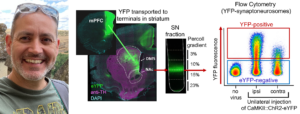 Hot Off the Press – June 27, 2023
Hot Off the Press – June 27, 2023
Published in The Journal of Neuroscience by Javier Rubio and Bruce Hope, et al. of the NIDA IRP Neuronal Ensembles in Drug Addiction Section.
The study is a novel approach to study molecular alterations in individual synapses using Flow Cytometry of Synaptoneurosomes (FCS). The FCS approach was used to identify activity-dependent increases of ribosomal protein S6 in post-synaptic endings and calcineurin in presynaptic terminals coming from mPFC to nucleus accumbens in rats. S6 and calcineurin may be useful markers to identify activated synaptic ensembles similar to how Fos is used as a marker to identify activated cell bodies in neuronal ensembles to study learning-induced plasticity changes. This project was a collaboration with several groups from NIDA-IRP and NIA-IRP, especially the participation of the Flow Cytometry Unit lead by Chris Dunn at NIA and the Confocal and Electron Microscopy Core lead by Steven Zhang at NIDA.
Publication Information
In: J Neuroci., vol. 43, iss. 23, pp. 4217-4233, 2023.
